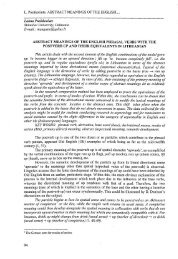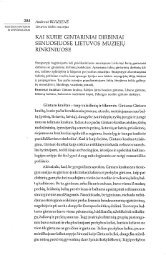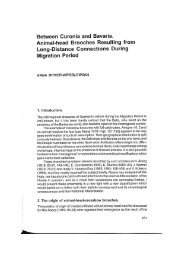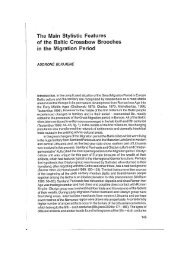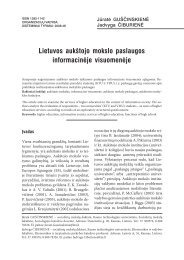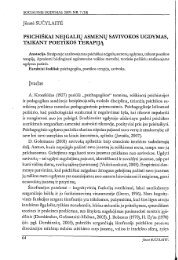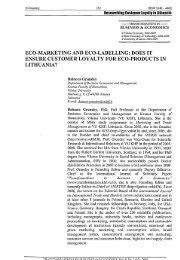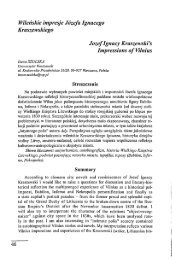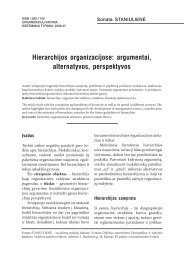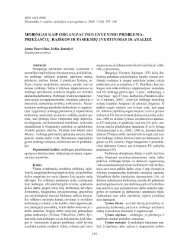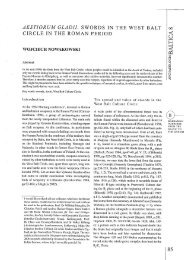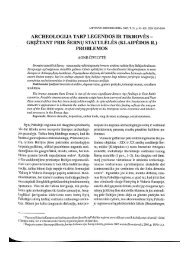adaptation of bank'sx risk management model to the new basel ...
adaptation of bank'sx risk management model to the new basel ...
adaptation of bank'sx risk management model to the new basel ...
Create successful ePaper yourself
Turn your PDF publications into a flip-book with our unique Google optimized e-Paper software.
48<br />
VADYBA / MANAGEMENT. 2006 m. Nr. 2(11)<br />
ADAPTATION OF BANK‘S X RISK MANAGEMENT MODEL TO THE NEW<br />
BASEL CAPITAL ACCORD USING ALGORITHM BASED ON PAIRED<br />
COMPARISON<br />
Algimantas Gaulia, Irena Ma�erinskien�<br />
Commercial banks face <strong>new</strong> challenges in <strong>risk</strong> <strong>management</strong> as <strong>the</strong>y adapt <strong>the</strong>ir <strong>risk</strong> <strong>management</strong> systems <strong>to</strong> <strong>the</strong> New<br />
Basel Capital Record, or Basel II. Basel II <strong>of</strong>fers choice <strong>of</strong> alternative <strong>risk</strong> <strong>management</strong> <strong>to</strong>ols, ranging from simple <strong>risk</strong><br />
weight approaches <strong>to</strong> advanced statistical data based approaches. Banks have <strong>to</strong> choose optimal for <strong>the</strong>m <strong>risk</strong> <strong>management</strong><br />
methods and implement <strong>the</strong>m. One method for choosing <strong>the</strong> alternatives is studied in this paper. Authors develop an<br />
algorithm, which is based on comparing compliance <strong>of</strong> alternative methods with criteria that have different weights that are<br />
determined by paired comparison method. Applying this algorithm <strong>to</strong> adapt <strong>risk</strong> <strong>management</strong> <strong>model</strong> <strong>of</strong> small Lithuanian<br />
bank X <strong>to</strong> Basel II showed that statistical data based <strong>risk</strong> <strong>management</strong> <strong>to</strong>ols can be used <strong>to</strong> improve bank’s <strong>risk</strong><br />
<strong>management</strong>, but in combination with o<strong>the</strong>r <strong>risk</strong> <strong>management</strong> methods and only if <strong>the</strong> <strong>risk</strong> is significant so that <strong>the</strong> benefits<br />
from adapting <strong>the</strong>m would be higher than <strong>the</strong> cost <strong>of</strong> adoption and usage.<br />
Key words: Basel II, <strong>risk</strong> <strong>management</strong>, paired comparison.<br />
Introduction<br />
One <strong>of</strong> <strong>the</strong> main issues for commercial banks is adoption <strong>of</strong> revised International Convergence <strong>of</strong> Capital<br />
Measurement and Capital Standards, or Basel II, that is set out here <strong>to</strong> be available for implementation as <strong>of</strong><br />
yearend 2006 (but banks can opt <strong>to</strong> apply current rules until end 2007). However, <strong>the</strong> Basel Committee <strong>of</strong><br />
Banking Supervision feels that one fur<strong>the</strong>r year <strong>of</strong> impact studies or parallel calculations will be needed for <strong>the</strong><br />
most advanced approaches, and <strong>the</strong>se <strong>the</strong>refore will be available for implementation as <strong>of</strong> year-end 2007. The<br />
<strong>new</strong> Basel Accord will be implemented in <strong>the</strong> European Union via <strong>the</strong> Capital Requirements Directive (CRD).<br />
Many commercial banks have <strong>to</strong> make a decision <strong>of</strong> how <strong>to</strong> adopt <strong>the</strong>ir <strong>risk</strong> <strong>management</strong> <strong>model</strong>s<br />
according <strong>to</strong> Basel II. In this light, using paired comparison method <strong>to</strong> choose one <strong>of</strong> <strong>the</strong> alternatives may be<br />
appropriate, that’s why <strong>the</strong> authors <strong>of</strong> this paper created an algorithm based on paired comparison method and<br />
used it <strong>to</strong> choose alternatives in adapting Bank’s X, small-sized Lithuanian bank’s <strong>risk</strong> <strong>management</strong> <strong>model</strong> <strong>to</strong><br />
Basel II.<br />
1. Key <strong>risk</strong>s and <strong>risk</strong> <strong>management</strong> <strong>model</strong>s<br />
There are many banking <strong>risk</strong>s. Most common approach is <strong>to</strong> group banking <strong>risk</strong>s <strong>to</strong> credit <strong>risk</strong>, liquidity<br />
<strong>risk</strong>, market <strong>risk</strong> and operational <strong>risk</strong>.<br />
Credit <strong>risk</strong><br />
Credit <strong>risk</strong> is described as <strong>the</strong> <strong>risk</strong> <strong>to</strong> have losses because counterparty is not capable <strong>to</strong> carry out its<br />
obligations according <strong>to</strong> <strong>the</strong> terms <strong>of</strong> <strong>the</strong> agreement. Sometimes losses occur even when <strong>the</strong> counterparty does<br />
not breach <strong>the</strong> contract, but <strong>the</strong>re are certain signs showing increasing probability <strong>of</strong> borrower’s insolvency<br />
(e.g. downgrade in credit ratings <strong>of</strong> <strong>the</strong> borrower).<br />
Credit <strong>risk</strong> is one <strong>of</strong> <strong>the</strong> key <strong>risk</strong>s for <strong>the</strong> banks as failure <strong>to</strong> properly evaluate it may lead <strong>to</strong> insolvency<br />
and bankruptcy. Aggregated stress testing <strong>of</strong> Lithuanian banks results <strong>of</strong> <strong>the</strong> yr. 2002 showed that banks<br />
consider credit <strong>risk</strong> <strong>to</strong> be <strong>the</strong> most important <strong>risk</strong>, constituting over 62% <strong>of</strong> possible losses [6].<br />
Basel II suggests 3 alternative approaches for credit <strong>risk</strong> <strong>management</strong> – Standard approach, Foundation<br />
Internal Ratings Based (F-IRB) approach and Advanced Internal Ratings Based (A-IRB) approach. Using<br />
standard approach, capital coverage is calculated by applying certain <strong>risk</strong> weights <strong>to</strong> certain balance sheet<br />
items. Internal ratings based approaches calculated capital coverage as function <strong>of</strong> PD (probability <strong>of</strong> default),<br />
LGD (loss given default), EAD (exposure at default) and M (maturity). The difference between F-IRB and A-<br />
IRB is that under F-IRB approach banks rely on more supervisory estimates than under A-IRB approach [3].<br />
Besides alternative approaches for capital coverage calculation, classic credit <strong>risk</strong> <strong>management</strong> <strong>to</strong>ols<br />
such as limit systems, credit scoring procedures, loan assessment procedures, <strong>risk</strong> diversification rules, etc. are<br />
necessary <strong>to</strong> use <strong>to</strong> keep credit <strong>risk</strong> as low as possible.
VADYBA / MANAGEMENT. 2006 m. Nr. 2(11) 49<br />
Table 1. Difference between F-IRB and A-IRB approaches<br />
Parameter F-IRB approach A-IRB approach<br />
PD Estimated by bank Estimated by bank<br />
LGD Set by supervisory institution Estimated by bank<br />
EAD Set by supervisory institution Estimated by bank<br />
M Set by supervisory institution Estimated by bank<br />
Liquidity <strong>risk</strong><br />
Liquidity <strong>risk</strong> is also <strong>risk</strong> <strong>of</strong> key importance <strong>to</strong> commercial banks as failure <strong>to</strong> properly manage this <strong>risk</strong><br />
may result in insolvency <strong>of</strong> <strong>the</strong> bank. Liquidity <strong>risk</strong> involves <strong>the</strong> possibility that earnings or capital will be<br />
negatively affected by an institution’s inability <strong>to</strong> meet its obligations when <strong>the</strong>y come due. Liquidity <strong>risk</strong> is<br />
<strong>the</strong> <strong>risk</strong> that <strong>the</strong> financial institution cannot settle an obligation for full value when it is due (even if it may be<br />
able <strong>to</strong> settle at some unspecified time in <strong>the</strong> future). Liquidity problems can result in opportunity costs,<br />
defaults in o<strong>the</strong>r obligations, or costs associated with obtaining <strong>the</strong> funds from some o<strong>the</strong>r source for some<br />
period <strong>of</strong> time [7]. In most cases, liquidity <strong>risk</strong> is <strong>the</strong> outcome <strong>of</strong> o<strong>the</strong>r <strong>risk</strong>s such as credit, strategic,<br />
reputation, interest rate and counterparty <strong>risk</strong>. For instance, when important large cus<strong>to</strong>mer becomes default,<br />
bank may have difficulties in meeting its obligations. Additionally, liquidity <strong>risk</strong> comes in <strong>the</strong> normal course <strong>of</strong><br />
business, usually as long-term assets are financed by short-term obligations.<br />
Liquidity <strong>risk</strong> is managed by analysing liquidity gaps (simple and marginal), using cash matching<br />
approach by setting limits for absolute or relative liquidity gaps, making projections <strong>of</strong> future cash flows,<br />
scenario testing. Value-at-<strong>risk</strong> (VaR) techniques using statistical data may be used for <strong>the</strong>se purposes.<br />
Market <strong>risk</strong><br />
Market <strong>risk</strong> is <strong>the</strong> <strong>risk</strong> <strong>of</strong> adverse deviations in price <strong>of</strong> financial items (equities, bonds, FX deals,<br />
derivatives, etc.) [4]. Market <strong>risk</strong> includes currency <strong>risk</strong>, interest rate <strong>risk</strong>, equity or debt security price <strong>risk</strong> etc.<br />
market <strong>risk</strong> may result both in positive and negative effects. In capital charge calculation, only <strong>the</strong> negative<br />
effects are taken in<strong>to</strong> account. Main goal in market <strong>risk</strong> <strong>management</strong> is <strong>to</strong> reliably estimate likely price<br />
fluctuations and <strong>to</strong> take decision whe<strong>the</strong>r <strong>to</strong> take <strong>the</strong> <strong>risk</strong> or <strong>to</strong> reduce it. Limit systems, gap analysis,<br />
correlation analysis, instrument sensitivity analysis, market volatility analysis can be used for market <strong>risk</strong><br />
<strong>management</strong>. The <strong>risk</strong> can be reduces by portfolio diversification or hedging using derivative financial<br />
instruments (swaps, forwards, options, etc.). Market <strong>risk</strong> can be measured by using <strong>risk</strong> weights or by using<br />
value-at-<strong>risk</strong> approaches. It’s important <strong>to</strong> note that in order <strong>to</strong> reach best <strong>risk</strong> <strong>management</strong> results, VaR-based<br />
approaches should be used in combination with o<strong>the</strong>r <strong>risk</strong> <strong>management</strong> methods as VaR <strong>model</strong>s rely on certain<br />
assumptions, not every time equilibrium between <strong>the</strong> accuracy and operativity is reached, output on <strong>the</strong> same<br />
data using different VaR <strong>model</strong>s may vary substantially.<br />
Operational <strong>risk</strong><br />
The definition <strong>of</strong> operational <strong>risk</strong> varies considerably since <strong>the</strong> list <strong>of</strong> fac<strong>to</strong>rs causing operational <strong>risk</strong> is<br />
incomplete and constantly growing due <strong>to</strong> increasing complexity <strong>of</strong> business. Basel Committee on Banking<br />
Supervision defines operational <strong>risk</strong> as <strong>the</strong> <strong>risk</strong> <strong>of</strong> direct or indirect loss resulting from inadequate or failed<br />
internal processes, people, and systems, or from external events [1]. Risk may actualise in technical level (IT<br />
system or <strong>risk</strong> measurement system inefficiency) or in organizational level (lack <strong>of</strong> procedures, non-adequate<br />
organization <strong>of</strong> <strong>risk</strong> moni<strong>to</strong>ring and reporting) [4]. Basel Committee on Banking Supervision considers<br />
operational <strong>risk</strong> <strong>to</strong> be <strong>of</strong> high importance, that’s why Basel II demands capital charge calculation for<br />
operational <strong>risk</strong>. Stress testing <strong>of</strong> Lithuanian banks in 2002 showed that Lithuanian banks consider that losses<br />
from operational <strong>risk</strong> would make 5% <strong>of</strong> all <strong>the</strong> losses [6]. Quantitative Impact Study 3 (QIS 3) calculation<br />
shows that operational <strong>risk</strong> capital charges increase regula<strong>to</strong>ry capital by 5-15% [2].<br />
As it is impossible <strong>to</strong> name all <strong>the</strong> <strong>risk</strong>s, it is suggested <strong>to</strong> determine fac<strong>to</strong>rs causing operational <strong>risk</strong>.<br />
After that <strong>the</strong> following algorithm can be used in determining whe<strong>the</strong>r <strong>to</strong> ignore <strong>the</strong> <strong>risk</strong> fac<strong>to</strong>r, or <strong>to</strong> take<br />
action.
50<br />
Do <strong>the</strong>y require<br />
<strong>management</strong>?<br />
N<br />
Risk is taken<br />
Identification <strong>of</strong> fac<strong>to</strong>rs<br />
causing <strong>risk</strong><br />
Y Are <strong>the</strong>se fac<strong>to</strong>rs<br />
N<br />
significant?<br />
Y<br />
What <strong>risk</strong> <strong>management</strong><br />
mehods exist?<br />
Risk <strong>management</strong> method is<br />
chosen and applied<br />
Fig. 1. Possible ways <strong>of</strong> reacting <strong>to</strong> <strong>risk</strong><br />
VADYBA / MANAGEMENT. 2006 m. Nr. 2(11)<br />
No action is taken while<br />
significance does not increase<br />
In order <strong>to</strong> determine whe<strong>the</strong>r significant fac<strong>to</strong>rs require <strong>management</strong> decision-matrix presented in <strong>the</strong><br />
table below can be helpful.<br />
Table 2. Decision-matrix for operational <strong>risk</strong> <strong>management</strong><br />
Probability <strong>of</strong><br />
<strong>the</strong> event<br />
Expected losses<br />
Minimal<br />
Maximal<br />
(Adapted from [5])<br />
Minimal Maximal<br />
No action is taken Risk is managed<br />
Risk is managed if<br />
cost <strong>of</strong> adoption <strong>of</strong> <strong>the</strong><br />
<strong>risk</strong> <strong>management</strong><br />
method is less than<br />
expected losses<br />
Risk is managed<br />
Basel II suggests 3 alternative methods <strong>to</strong> quantify operational <strong>risk</strong>: Basic Indica<strong>to</strong>r approach (gross<br />
income multiplied by <strong>risk</strong> weight), <strong>the</strong> Standardized approach (multiplying gross income from eight business<br />
lines by <strong>risk</strong> weights), or <strong>the</strong> Advanced Measurement approach (bank uses its own developed techniques with<br />
<strong>the</strong> consent <strong>of</strong> supervisory institution after meeting qualitative requirements) [3].<br />
2. Selection and assigning weights <strong>to</strong> criteria for comparison <strong>of</strong> alternative methods<br />
As selecting best suitable <strong>risk</strong> <strong>management</strong> approaches needs qualitative analysis, in order <strong>to</strong> make<br />
selection <strong>of</strong> <strong>the</strong> alternative methods quantified, adapted paired comparison method can be used. Five criteria<br />
characterizing methods are designated, and <strong>the</strong>y all are compared against each o<strong>the</strong>r, for every pair <strong>of</strong> <strong>the</strong><br />
criteria assigning 10 points. Results <strong>of</strong> this process are described below.
VADYBA / MANAGEMENT. 2006 m. Nr. 2(11) 51<br />
Pair <strong>of</strong><br />
criteria<br />
List <strong>of</strong> criteria:<br />
A. Accuracy <strong>of</strong> <strong>the</strong> method<br />
B. Cost <strong>of</strong> <strong>the</strong> adoption <strong>of</strong> <strong>the</strong> method<br />
C. Cost <strong>of</strong> using <strong>the</strong> method<br />
D. Reduction <strong>of</strong> losses when <strong>the</strong> method is applied<br />
E. Changes in capital charges calculated using <strong>the</strong> method.<br />
Result <strong>of</strong> <strong>the</strong><br />
comparison <strong>of</strong><br />
<strong>the</strong> criteria<br />
Table 3. Comparison <strong>of</strong> pairs <strong>of</strong> criteria<br />
Reasoning <strong>of</strong> <strong>the</strong> result<br />
A-B A – 2 B – 8 If bank does not have enough funds <strong>to</strong> adopt <strong>the</strong> most accurate approach, it can’t adopt it. But<br />
if adoption <strong>of</strong> two alternative approaches costs <strong>the</strong> same, <strong>the</strong> accurate one should be chosen<br />
A-C A – 5 C – 5 If <strong>model</strong> A is more accurate than <strong>model</strong> B, and cost <strong>of</strong> using <strong>the</strong> <strong>model</strong> is <strong>the</strong> same or <strong>model</strong><br />
A using cost is lower than <strong>model</strong> B using cost – <strong>model</strong> A should be chosen; if <strong>the</strong> accuracy <strong>of</strong><br />
<strong>model</strong>s A and B is <strong>the</strong> same and <strong>model</strong> A using costs are higher – <strong>model</strong> B should be chosen;<br />
if <strong>the</strong> accuracy <strong>of</strong> <strong>model</strong> A is higher than <strong>the</strong> accuracy <strong>of</strong> <strong>model</strong> B, but <strong>the</strong> cost <strong>of</strong> using<br />
<strong>model</strong> A is higher than <strong>the</strong> cost <strong>of</strong> using <strong>model</strong> B – choice <strong>of</strong> <strong>the</strong> <strong>model</strong> would depend on<br />
o<strong>the</strong>r fac<strong>to</strong>rs.<br />
A-D A – 3 D – 7 If <strong>the</strong> <strong>model</strong> leads <strong>to</strong> reduction <strong>of</strong> <strong>the</strong> cost, it is more important than <strong>the</strong> accuracy <strong>of</strong> <strong>the</strong> <strong>model</strong><br />
since <strong>the</strong> purpose <strong>of</strong> <strong>risk</strong> <strong>management</strong> is reducing <strong>the</strong> cost; despite that, criteria A gets 3<br />
points because overestimating criteria D can lead <strong>to</strong> <strong>to</strong>o liberal approach <strong>to</strong>wards <strong>the</strong> <strong>risk</strong><br />
<strong>management</strong> which under negative circumstances may result in losses later.<br />
A-E A – 7 E – 3 Capital is <strong>the</strong> most expensive <strong>of</strong> all resources; despite that, purpose <strong>of</strong> <strong>risk</strong> <strong>management</strong> is not<br />
<strong>to</strong> reduce capital charges, but <strong>to</strong> calculate <strong>the</strong>m as accurately as possible and reasonable<br />
B-C B – 5 C – 5 Net present value <strong>of</strong> projected cash flows should be used. If NPV <strong>of</strong> alternatives is equal,<br />
selecting better method depends on o<strong>the</strong>r fac<strong>to</strong>rs.<br />
B-D B – 6 D – 4 Adoption are usually clear and easy <strong>to</strong> calculate, and positive outcome from reduction <strong>of</strong><br />
losses usually depends on certain assumptions i.e. is less clear<br />
B-E B – 3 E – 7 If bank is financially capable <strong>to</strong> adopt a <strong>model</strong>, which would reduce capital costs, and <strong>the</strong><br />
NPV <strong>of</strong> reduction <strong>of</strong> capital cost is higher than <strong>the</strong> NPV <strong>of</strong> adoption costs, it would be useful<br />
<strong>to</strong> adopt <strong>the</strong> <strong>model</strong><br />
C-D C – 5 D – 5 If using costs <strong>of</strong> <strong>the</strong> <strong>model</strong> were P, reduction <strong>of</strong> losses when <strong>model</strong> was applied were K,<br />
<strong>model</strong> – M, selection between <strong>model</strong> A & B would be <strong>the</strong> following:<br />
PA – PB > KA – KB, –> MB<br />
PA – PB < KA – KB, –> MA<br />
PA – PB = KA – KB, –> choice depends on o<strong>the</strong>r fac<strong>to</strong>rs<br />
C-E C – 6 E – 4 In case adoption cost and positive effect from changes in regula<strong>to</strong>ry capital were equal,<br />
selection would depend on o<strong>the</strong>r fac<strong>to</strong>rs. But adoption cost can be measured more reliably.<br />
D-E D – 7 E – 3 As reduction in capital costs does not always mean better <strong>risk</strong> <strong>management</strong>, projected<br />
positive effect from cost reduction is more important<br />
The results <strong>of</strong> all paired comparisons <strong>of</strong> <strong>the</strong> criteria are presented in paired comparison matrix.<br />
Table 4. Result <strong>of</strong> paired comparison <strong>of</strong> criteria<br />
Criteria A B C D E Total<br />
A 2 5 3 7 17<br />
B 8 5 6 3 22<br />
C 5 5 5 6 21<br />
D 7 4 5 7 23<br />
E 3 7 4 3 17<br />
3. Algorithm for assessment and selection <strong>of</strong> <strong>risk</strong> <strong>management</strong> methods<br />
Risk <strong>management</strong> methods used in Bank X will be assessed by using this algorithm (Fig. 2.)
52<br />
Improvement is rejected<br />
Y<br />
No changes are applied<br />
N<br />
Is <strong>the</strong> <strong>risk</strong> <strong>management</strong> <strong>model</strong> adequate, meets <strong>the</strong> criteria<br />
<strong>of</strong> Basel II and it is impossible <strong>to</strong> improve it?<br />
N<br />
Are likely benefits from <strong>the</strong><br />
improvement <strong>of</strong> <strong>the</strong> <strong>model</strong> higher<br />
than <strong>the</strong> cost <strong>of</strong> adoption?<br />
Y<br />
Improvement is adopted<br />
VADYBA / MANAGEMENT. 2006 m. Nr. 2(11)<br />
N<br />
Are <strong>the</strong>re any<br />
alternative methods for <strong>the</strong>improvement<br />
<strong>of</strong> <strong>the</strong> <strong>model</strong>?<br />
Fig. 2. Algorithm for assessment <strong>of</strong> <strong>risk</strong> <strong>management</strong> methods<br />
Y<br />
Algorithm depicted in picture 2 for selection<br />
<strong>of</strong> <strong>the</strong> best alternative is applied<br />
If <strong>the</strong>re are alternative methods available, optimal method for bank X is selected by using <strong>the</strong> algorithm<br />
presented below. Alternative <strong>risk</strong> <strong>management</strong> methods will be compared according <strong>to</strong> <strong>the</strong>ir compliance <strong>to</strong> <strong>the</strong><br />
criteria presented in section 2, above. Compliance <strong>to</strong> <strong>the</strong> criteria (CC) is measured with a scale ranging from 0<br />
(<strong>to</strong>tally does not comply) up <strong>to</strong> 10 (<strong>to</strong>tally complies). Criteria will have influence <strong>to</strong> overall result (CI) such as<br />
stated in paired comparison matrix. Score for <strong>the</strong> <strong>model</strong> (SM) is calculated using <strong>the</strong> formula below.<br />
SM = (CC/10) * (CI/100); (1)<br />
The <strong>model</strong> that has highest SM is chosen.<br />
Y<br />
START<br />
Ar <strong>model</strong>is Does <strong>the</strong> atitinka <strong>model</strong> Basel meet II N<br />
<strong>the</strong> requirements <strong>of</strong><br />
sutarties Basel reikalavimus? II?<br />
Assessment <strong>of</strong> how <strong>model</strong> matches criteria is performed<br />
Model is selected<br />
The score for <strong>the</strong> <strong>model</strong> is calculated<br />
Is <strong>model</strong>’s score highest compared <strong>to</strong> <strong>the</strong><br />
alternative <strong>model</strong>s for <strong>management</strong> <strong>of</strong> <strong>the</strong><br />
same <strong>risk</strong>?<br />
Y<br />
FINISH<br />
Model is rejected<br />
N<br />
Steps are applied for all<br />
<strong>model</strong>s<br />
Fig. 3. Algorithm for choosing one <strong>of</strong> <strong>the</strong> alternative <strong>risk</strong> <strong>management</strong> methods
VADYBA / MANAGEMENT. 2006 m. Nr. 2(11) 53<br />
4. Selection <strong>of</strong> <strong>the</strong> <strong>model</strong>s for credit <strong>risk</strong> <strong>management</strong><br />
Bank X uses classic <strong>risk</strong> <strong>management</strong> methods - credit limit system, counterparty <strong>risk</strong> <strong>management</strong><br />
systems, <strong>risk</strong> diversification rules. These <strong>to</strong>ols are efficient, comply with Basel II and are suitable for fur<strong>the</strong>r<br />
usage. But calculation <strong>of</strong> capital charges for credit <strong>risk</strong> <strong>of</strong> bank X does not comply with Basel II requirements,<br />
that’s why <strong>the</strong> choice between Standard, F-IRB and A-IRB approaches will have <strong>to</strong> be made.<br />
Compliance <strong>of</strong> alternative approaches with Criterion A (accuracy <strong>of</strong> approaches)<br />
A-IRB approach will without doubts comply with criteria A since all <strong>the</strong> parameters are set by <strong>the</strong> bank,<br />
using actual statistical data. F-IRB approach will comply less with this criteria, but still some <strong>of</strong> <strong>the</strong> parameters<br />
will be set by using actual statistical data. The accuracy <strong>of</strong> Standard approach is doubtful, since statistical data<br />
do not have direct influence <strong>to</strong> <strong>the</strong> quantification <strong>of</strong> <strong>risk</strong>. Compliance with criterion A can be assessed <strong>the</strong><br />
following:<br />
A-IRB: 10/10 F-IRB: 6/10 Standard: 1/10.<br />
Compliance <strong>of</strong> alternative approaches with Criterion B (cost <strong>of</strong> <strong>the</strong> adoption)<br />
Since bank X currently uses approach similar <strong>to</strong> Standard approach, and <strong>the</strong> adoption <strong>of</strong> Standard<br />
approach would be just a modification <strong>of</strong> current approach, <strong>the</strong> cost <strong>of</strong> adoption <strong>of</strong> Standard approach would<br />
be lowest. Creating statistical databases costs a lot <strong>of</strong> money, and due <strong>to</strong> size <strong>of</strong> Lithuanian banking market,<br />
joint databases are necessary for <strong>the</strong> ga<strong>the</strong>ring <strong>of</strong> necessary information. The more variables are assessed in <strong>the</strong><br />
<strong>model</strong>, <strong>the</strong> more data needs <strong>to</strong> be ga<strong>the</strong>red, and <strong>the</strong> more difficult and expensive is <strong>the</strong> adoption <strong>of</strong> <strong>the</strong> <strong>model</strong>.<br />
That’s why adoption <strong>of</strong> A-IRB approach would be <strong>the</strong> most costly (this also is mentioned in many studies).<br />
Rating <strong>of</strong> approaches according <strong>the</strong>ir compliance with criterion B is <strong>the</strong> following:<br />
A-IRB: 0/10 F-IRB: 4/10 Standard: 10/10.<br />
Compliance <strong>of</strong> alternative approaches with Criterion C (cost <strong>of</strong> using <strong>the</strong> approach)<br />
The more complicated <strong>the</strong> <strong>model</strong> is, <strong>the</strong> more statistical data is used, and <strong>the</strong> higher is <strong>the</strong> method using<br />
cost. Cost <strong>of</strong> using standard method would be lowest as <strong>the</strong> bank would not increase it’s current workload.<br />
Internal ratings based methods require statistical data, which should be obtained from internal, or external<br />
databases that would result in higher cost. Rating <strong>of</strong> approaches according <strong>the</strong>ir compliance with criterion C is<br />
<strong>the</strong> following:<br />
A-IRB: 0/10 F-IRB: 4/10 Standard: 10/10.<br />
Compliance <strong>of</strong> alternative approaches with Criterion D (reduction <strong>of</strong> losses when <strong>the</strong> approach is<br />
applied)<br />
The Standard approach is just <strong>the</strong> modification <strong>of</strong> current approach, so reduction <strong>of</strong> losses when this<br />
approach is applied should not be expected. Internal ratings based approaches mean qualitative improvement in<br />
bank’s credit <strong>risk</strong> <strong>management</strong>. Basel II implies qualitative criteria that should be met in order <strong>to</strong> apply internal<br />
ratings based approaches, and compliance with <strong>the</strong>se criteria will surely help increase <strong>the</strong> quality <strong>of</strong> decisionmaking<br />
and reduce <strong>the</strong> losses due <strong>to</strong> improper credit <strong>risk</strong> <strong>management</strong>. As A-IRB approach uses <strong>the</strong> most<br />
statistical data and banks must meet strictest requirements <strong>to</strong> adopt it, this approach scores highest in<br />
compliance with this criterion. F-IRB approach would still mean qualitative improvement, so it gets more than<br />
average CI score. Rating <strong>of</strong> approaches according <strong>to</strong> <strong>the</strong>ir compliance with criterion D is <strong>the</strong> following:<br />
A-IRB: 10/10 F-IRB: 8/10 Standard: 0/10.<br />
Compliance <strong>of</strong> alternative approaches with Criterion E (changes in capital charges calculated<br />
using <strong>the</strong> method)<br />
Standard approach would result in highest capital charges. Two main arguments back-up this statement:<br />
first, most <strong>of</strong> Lithuanian enterprises are <strong>to</strong>o small <strong>to</strong> use <strong>the</strong> services <strong>of</strong> credit rating agencies, and even if <strong>the</strong>y<br />
got rated, <strong>the</strong>y most likely would get credit rating lower than Lithuanian sovereign credit rating (which<br />
currently is at lowest investment grade), which will result in <strong>risk</strong> weight <strong>of</strong> 100% or even higher. Second,<br />
results <strong>of</strong> QIS 3 show that adoption <strong>of</strong> standard approach leads <strong>to</strong> highest capital charges compared <strong>to</strong> internal<br />
ratings based approaches. Of <strong>the</strong> F-IRB and A-IRB approaches, capital charges are lower for A-IRB approach<br />
[2].<br />
Rating <strong>of</strong> approaches according <strong>the</strong>ir compliance with criterion E is <strong>the</strong> following:<br />
A-IRB: 10/10 F-IRB: 8/10 Standard: 0/10.
54<br />
VADYBA / MANAGEMENT. 2006 m. Nr. 2(11)<br />
Selection <strong>of</strong> <strong>the</strong> approach<br />
After calculation <strong>of</strong> compliance <strong>of</strong> alternative approaches with <strong>the</strong> criteria, <strong>the</strong> score for <strong>the</strong> <strong>model</strong> (SM)<br />
is calculated for each <strong>of</strong> <strong>the</strong> alternative approaches in <strong>the</strong> Table 5.<br />
Approach<br />
Table 5. Result <strong>of</strong> comparison <strong>of</strong> credit <strong>risk</strong> <strong>management</strong> approaches<br />
A<br />
(max. 17)<br />
B<br />
(max. 22)<br />
C<br />
(max. 21)<br />
SM<br />
D<br />
(max. 23)<br />
E<br />
(max. 17)<br />
Standard 1.7 22.0 21.0 0.0 0.0 44.7<br />
F-IRB 10.2 8.8 8.4 18.4 13.6 59.4<br />
A-IRB 17.0 0.0 0.0 23.0 17.0 57.0<br />
As <strong>the</strong> table shows, bank X should choose F-IRB approach for assessment <strong>of</strong> credit <strong>risk</strong>.<br />
5. Selection <strong>of</strong> <strong>the</strong> <strong>model</strong>s for liquidity <strong>risk</strong> <strong>management</strong><br />
Bank X uses liquidity gaps, projected cash flows and internal liquidity limits for liquidity <strong>management</strong>.<br />
The liquidity <strong>risk</strong> <strong>management</strong> system meets its objectives, but <strong>the</strong>re is room for possible improvement: bank<br />
X could possibly adopt VaR measures <strong>to</strong> make projections <strong>of</strong> cus<strong>to</strong>mer cash flows. This would help <strong>to</strong> make<br />
cash flow planning more precise that could result in less strict internal liquidity limits and select more<br />
pr<strong>of</strong>itable opportunities for <strong>the</strong> investment <strong>of</strong> spare funds. Additionally, <strong>the</strong>se measures would allow analysing<br />
not only retrospective, but also prospective liquidity gaps. As this would result in improvement <strong>of</strong> bank’s X<br />
liquidity <strong>management</strong> system and projected benefits are higher than <strong>the</strong> projected costs, this improvement<br />
should be adopted.<br />
6. Selection <strong>of</strong> <strong>the</strong> <strong>model</strong>s for market <strong>risk</strong> <strong>management</strong><br />
Currently, bank X uses interest rate gap method and internal limits for interest rate <strong>risk</strong> <strong>management</strong>,<br />
additionally by projecting changes in market rates and <strong>the</strong> impact <strong>of</strong> <strong>the</strong>se changes <strong>to</strong> bank’s pr<strong>of</strong>itability. Of<br />
<strong>the</strong> o<strong>the</strong>r market <strong>risk</strong>s, currency <strong>risk</strong> is <strong>the</strong> most important <strong>to</strong> <strong>the</strong> bank X: in yr. 200X, income from operations<br />
with foreign currency and derivatives made 80% <strong>of</strong> bank’s trading income. There are aggregate and single<br />
open currency limits set by <strong>the</strong> Bank <strong>of</strong> Lithuania, additionally stricter internal open currency limits for <strong>the</strong><br />
daytime and end <strong>of</strong> day are imposed. Excess positions are hedged using derivative financial instruments. O<strong>the</strong>r<br />
market <strong>risk</strong>s are not <strong>of</strong> high importance <strong>to</strong> <strong>the</strong> bank X: in yr. 200X, income from operations with bonds and<br />
equities made 4% <strong>of</strong> gross income, bonds and equities made just about 1% <strong>of</strong> bank’s X assets. Bank uses limits<br />
in order <strong>to</strong> diversify equity/bond portfolio. Capital charges for market <strong>risk</strong>s are calculated by applying <strong>risk</strong><br />
weights.<br />
Diversification and limits for financial items is effective and has no alternatives, but <strong>the</strong> calculation <strong>of</strong><br />
market volatilities and capital charges could be made more accurate by adopting VaR measures. That’s why<br />
algorithm described above will be use <strong>to</strong> select better alternative <strong>of</strong> calculation <strong>of</strong> capital charges – ei<strong>the</strong>r <strong>risk</strong><br />
weights, ei<strong>the</strong>r VaR measures. Since <strong>the</strong> most important market <strong>risk</strong>s for bank X are interest rate <strong>risk</strong>, currency<br />
<strong>risk</strong> and equity <strong>risk</strong>, <strong>the</strong> compliance <strong>of</strong> <strong>the</strong>se <strong>risk</strong>s with <strong>the</strong> criteria will be measured separately.<br />
Compliance <strong>of</strong> alternative approaches with Criterion A (accuracy <strong>of</strong> approaches)<br />
VaR approaches rely on statistical market data, <strong>risk</strong> weight approaches do not directly link <strong>to</strong> market<br />
movements, that’s why rating <strong>of</strong> approaches according <strong>the</strong>ir compliance with criterion A is <strong>the</strong> following:<br />
Interest rate <strong>risk</strong>: <strong>risk</strong> weight approaches: 0/10 VaR approaches: 10/10.<br />
Currency <strong>risk</strong>: <strong>risk</strong> weight approaches: 0/10 VaR approaches: 10/10.<br />
Security <strong>risk</strong>: <strong>risk</strong> weight approaches: 0/10 VaR approaches: 10/10.<br />
Compliance <strong>of</strong> alternative approaches with Criterion B (cost <strong>of</strong> <strong>the</strong> adoption)<br />
Using <strong>risk</strong> weight approaches would require no additional costs while adoption <strong>of</strong> VaR approaches<br />
would have costs. Rating <strong>of</strong> approaches according <strong>the</strong>ir compliance with criterion B is <strong>the</strong> following:<br />
Interest rate <strong>risk</strong>: <strong>risk</strong> weight approaches: 10/10 VaR approaches: 0/10.<br />
Total
VADYBA / MANAGEMENT. 2006 m. Nr. 2(11) 55<br />
Currency <strong>risk</strong>: <strong>risk</strong> weight approaches: 10/10 VaR approaches: 0/10.<br />
Security <strong>risk</strong>: <strong>risk</strong> weight approaches: 10/10 VaR approaches: 0/10.<br />
Compliance <strong>of</strong> alternative approaches with Criterion C (cost <strong>of</strong> using <strong>the</strong> approach)<br />
It is <strong>the</strong> same situation as in compliance with previous criterion:<br />
Interest rate <strong>risk</strong>: <strong>risk</strong> weight approaches: 10/10 VaR approaches: 0/10.<br />
Currency <strong>risk</strong>: <strong>risk</strong> weight approaches: 10/10 VaR approaches: 0/10.<br />
Security <strong>risk</strong>: <strong>risk</strong> weight approaches: 10/10 VaR approaches: 0/10.<br />
Compliance <strong>of</strong> alternative approaches with Criterion D (reduction <strong>of</strong> losses when <strong>the</strong> approach is<br />
applied)<br />
Situation is different for different types <strong>of</strong> <strong>risk</strong>s: for interest rate and currency <strong>risk</strong> <strong>management</strong><br />
purposes, adoption <strong>of</strong> VaR measures would give information that would help in decision-making process, it<br />
would help <strong>to</strong> set adequate limits and apply appropriate tactics. While in case <strong>of</strong> security <strong>risk</strong>, due <strong>to</strong> <strong>the</strong> small<br />
size <strong>of</strong> portfolio, it is not likely that possible positive effects would outweigh <strong>the</strong> cost <strong>of</strong> <strong>the</strong> adoption. While<br />
<strong>the</strong> trading equity/bond portfolio is this small, it is better <strong>to</strong> allocate <strong>the</strong> resources <strong>to</strong>wards o<strong>the</strong>r fields <strong>of</strong><br />
activity. Rating <strong>of</strong> approaches according <strong>the</strong>ir compliance with criterion D is <strong>the</strong> following:<br />
Interest rate <strong>risk</strong>: <strong>risk</strong> weight approaches: 0/10 VaR approaches: 10/10.<br />
Currency <strong>risk</strong>: <strong>risk</strong> weight approaches: 0/10 VaR approaches: 10/10.<br />
Security <strong>risk</strong>: <strong>risk</strong> weight approaches: 7/10 VaR approaches: 3/10.<br />
Compliance <strong>of</strong> alternative approaches with Criterion E (changes in capital charges calculated<br />
using <strong>the</strong> method)<br />
Calculations done by <strong>the</strong> author show that as for currency <strong>risk</strong>, capital charge calculated using his<strong>to</strong>rical<br />
VaR would be approximately 2 times lower than capital charge calculated using <strong>risk</strong> weights. If <strong>the</strong> bank does<br />
not specialize in <strong>risk</strong>y operations, usually calculation by <strong>risk</strong> weights results in higher capital charges than<br />
calculation using VaR.<br />
Rating <strong>of</strong> approaches according <strong>the</strong>ir compliance with criterion E is <strong>the</strong> following:<br />
Interest rate <strong>risk</strong>: <strong>risk</strong> weight approaches: 0/10 VaR approaches: 10/10.<br />
Currency <strong>risk</strong>: <strong>risk</strong> weight approaches: 0/10 VaR approaches: 10/10.<br />
Security <strong>risk</strong>: <strong>risk</strong> weight approaches: 0/10 VaR approaches: 10/10.<br />
Selection <strong>of</strong> <strong>the</strong> approach<br />
After calculation <strong>of</strong> compliance <strong>of</strong> alternative approaches with <strong>the</strong> criteria, <strong>the</strong> score for <strong>the</strong> <strong>model</strong> (SM)<br />
is calculated for each <strong>of</strong> <strong>the</strong> alternative approaches in <strong>the</strong> Tables 6-8.<br />
Table 6. Result <strong>of</strong> comparison <strong>of</strong> interest rate <strong>risk</strong> <strong>management</strong> approaches<br />
Method<br />
A<br />
(max. 17)<br />
B<br />
(max. 22)<br />
C<br />
(max. 21)<br />
SM<br />
D<br />
(max. 23)<br />
E<br />
(max. 17)<br />
Risk weights 0.0 22.0 22.0 0.0 0.0 44.0<br />
VaR 17.0 0.0 0.0 23.0 17.0 57.0<br />
Table 7. Result <strong>of</strong> comparison <strong>of</strong> currency <strong>risk</strong> <strong>management</strong> approaches<br />
Method<br />
A<br />
(max. 17)<br />
B<br />
(max. 22)<br />
C<br />
(max. 21)<br />
SM<br />
D<br />
(max. 23)<br />
E<br />
(max. 17)<br />
Risk weights 0.0 22.0 22.0 0.0 0.0 44.0<br />
Total<br />
Total<br />
VaR 17.0 0.0 0.0 23.0 17.0 57.0
56<br />
VADYBA / MANAGEMENT. 2006 m. Nr. 2(11)<br />
Table 8. Result <strong>of</strong> comparison <strong>of</strong> security <strong>risk</strong> <strong>management</strong> approaches<br />
Method<br />
A<br />
(max. 17)<br />
B<br />
(max. 22)<br />
C<br />
(max. 21)<br />
SM<br />
D<br />
(max. 23)<br />
E<br />
(max. 17)<br />
Risk weight 0.0 22.0 22.0 16.1 0.0 60.1<br />
VaR 17.0 0.0 0.0 6.9 17.0 40.9<br />
As it is seen from <strong>the</strong> tables, adoption <strong>of</strong> VaR measures would be appropriate for interest rate and<br />
currency <strong>risk</strong> <strong>management</strong>, but for measurement <strong>of</strong> security <strong>risk</strong>, <strong>risk</strong> weight measures would be more<br />
appropriate since <strong>the</strong> security <strong>risk</strong> is insignificant for <strong>the</strong> bank X and likely benefits from VaR measures cannot<br />
outweigh <strong>the</strong> cost <strong>of</strong> adoption <strong>of</strong> <strong>the</strong>se measures.<br />
7. Selection <strong>of</strong> <strong>the</strong> <strong>model</strong>s for operational <strong>risk</strong> <strong>management</strong><br />
There are many operational <strong>risk</strong>s, every needs individual <strong>management</strong> method. That’s why just <strong>the</strong><br />
alternative operational <strong>risk</strong> measurement approaches (Basic Indica<strong>to</strong>r, Standard, Advanced Measurement) will<br />
be studied in this paper.<br />
Compliance <strong>of</strong> alternative approaches with Criterion A (accuracy <strong>of</strong> approaches)<br />
Basic indica<strong>to</strong>r approach does not reflect any <strong>of</strong> bank’s activities; it’s just a ratio time’s gross income.<br />
Standard approach takes in<strong>to</strong> account business lines <strong>of</strong> bank’s activity but still does not reflect anything with<br />
much accuracy. Rating <strong>of</strong> approaches according <strong>the</strong>ir compliance with criterion A is <strong>the</strong> following:<br />
Basic indica<strong>to</strong>r approach: 0/10 Standard approach: 2/10 Advanced Measurement approach:<br />
10/10<br />
Compliance <strong>of</strong> alternative approaches with Criterion B (cost <strong>of</strong> <strong>the</strong> adoption)<br />
Using Basic Indica<strong>to</strong>r or Standard approaches would require no additional costs while adoption <strong>of</strong><br />
Advanced Measurement approaches would have costs. But Advanced Measurement Approach does not get<br />
minimal score, because some improvements would need <strong>to</strong> be included in operational <strong>risk</strong> <strong>management</strong> system<br />
even without adopting this approach anyway. Rating <strong>of</strong> approaches according <strong>the</strong>ir compliance with criterion<br />
B is <strong>the</strong> following:<br />
Basic indica<strong>to</strong>r approach: 10/10 Standard approach: 10/10 Advanced Measurement approach:<br />
5/10<br />
Compliance <strong>of</strong> alternative approaches with Criterion C (cost <strong>of</strong> using <strong>the</strong> approach)<br />
It’s similar situation as in compliance with previous criterion. As using Advanced Measurement<br />
approach requires constant reporting, it would be needed <strong>to</strong> carry out not regarding which measurement<br />
approach is used. Rating <strong>of</strong> approaches according <strong>the</strong>ir compliance with criterion C is <strong>the</strong> following:<br />
Basic indica<strong>to</strong>r approach: 10/10 Standard approach: 10/10 Advanced Measurement approach:<br />
6/10<br />
Compliance <strong>of</strong> alternative approaches with Criterion D (reduction <strong>of</strong> losses when <strong>the</strong> approach is<br />
applied)<br />
The only approach that has relevance <strong>to</strong> <strong>risk</strong> <strong>management</strong> situation is Advanced Measurement approach.<br />
Basic indica<strong>to</strong>r approach: 0/10 Standard approach: 0/10 Advanced Measurement approach:<br />
10/10<br />
Compliance <strong>of</strong> alternative approaches with Criterion E (changes in capital charges calculated<br />
using <strong>the</strong> method)<br />
If <strong>the</strong> bank is not engaged in very <strong>risk</strong>y activities, Basic Indica<strong>to</strong>r and Standard approaches should result<br />
in higher capital charges. Additionally, when Advanced Measurement approach is applied, bank will be<br />
allowed <strong>to</strong> recognize <strong>the</strong> <strong>risk</strong> mitigating impact <strong>of</strong> insurance in <strong>the</strong> measures <strong>of</strong> operational <strong>risk</strong> used for<br />
regula<strong>to</strong>ry minimum capital requirements.<br />
Total
VADYBA / MANAGEMENT. 2006 m. Nr. 2(11) 57<br />
Rating <strong>of</strong> approaches according <strong>the</strong>ir compliance with criterion E is <strong>the</strong> following:<br />
Basic indica<strong>to</strong>r approach: 0/10 Standard approach: 3/10 Advanced Measurement approach:<br />
10/10<br />
After calculation <strong>of</strong> compliance <strong>of</strong> alternative approaches with <strong>the</strong> criteria, <strong>the</strong> score for <strong>the</strong> <strong>model</strong> (SM)<br />
is calculated for each <strong>of</strong> <strong>the</strong> alternative approaches in <strong>the</strong> Table 9.<br />
Table 9. Result <strong>of</strong> comparison <strong>of</strong> operational <strong>risk</strong> <strong>management</strong> approaches<br />
Approach<br />
A<br />
(max. 17)<br />
B<br />
(max. 22)<br />
C<br />
(max. 21)<br />
SM<br />
D<br />
(max. 23)<br />
E<br />
(max. 17)<br />
Basic Indica<strong>to</strong>r 0.0 22.0 22.0 0.0 0.0 44.0<br />
Standard 3.4 22.0 22.0 0.0 5.1 52.5<br />
Advanced Measurement 17.0 11.0 12.6 23.0 17.0 80.6<br />
As seen from table, adoption <strong>of</strong> Advanced Measurement approach would be most suitable for<br />
operational <strong>risk</strong> measurement.<br />
Conclusion<br />
Commercial banks cope with many <strong>risk</strong>s, <strong>the</strong> most important <strong>of</strong> which are credit, market, operational and<br />
liquidity <strong>risk</strong>s. As modern banking technologies develop, <strong>new</strong> <strong>risk</strong>s occur. Statistical <strong>risk</strong> <strong>management</strong><br />
methods, that combined with o<strong>the</strong>r <strong>management</strong> methods give good results, are becoming more popular and<br />
widely used. In order <strong>to</strong> adapt <strong>the</strong>ir <strong>risk</strong> <strong>management</strong> systems <strong>to</strong> Basel II, most commercial banks will have <strong>to</strong><br />
make changes in <strong>the</strong>ir <strong>risk</strong> <strong>management</strong> <strong>model</strong>s. This study showed how paired comparison method could be<br />
adapted <strong>to</strong> give weights <strong>to</strong> selected criteria, and how <strong>the</strong>se criteria could be used <strong>to</strong> improve and adapt <strong>risk</strong><br />
<strong>management</strong> <strong>model</strong> <strong>of</strong> <strong>the</strong> small Lithuanian bank X <strong>to</strong> <strong>the</strong> Basel II. It came <strong>to</strong> <strong>the</strong> conclusion that adding<br />
statistical VaR based approaches <strong>to</strong> bank’s X <strong>risk</strong> <strong>management</strong> <strong>model</strong>s would help <strong>to</strong> improve <strong>risk</strong><br />
<strong>management</strong>, but only combined with <strong>the</strong> classic <strong>risk</strong> <strong>management</strong> methods and that if certain <strong>risk</strong> is not <strong>of</strong><br />
significant importance (e.g. security <strong>risk</strong> for bank X), usage <strong>of</strong> VaR would not give optimal result as<br />
implementation and usage costs <strong>of</strong> this <strong>model</strong> are higher than likely benefits. On <strong>the</strong> o<strong>the</strong>r hand, though<br />
associated with costs, adoption <strong>of</strong> more advanced <strong>risk</strong> <strong>management</strong> methods would give positive results <strong>to</strong> <strong>the</strong><br />
bank through improved accuracy <strong>of</strong> <strong>risk</strong> <strong>management</strong>, reduction <strong>of</strong> losses from <strong>the</strong> <strong>risk</strong> and better allocated<br />
capital.<br />
REFERENCES<br />
1. Basel Committee on Banking Supervision Overview <strong>of</strong> New Capital Accord, 2001 // http://www.bis.org<br />
2. Basel Committee on Banking Supervision Quantitative Impact Study 3 – Overview <strong>of</strong> Global Results, May 2003 //<br />
http://www.bis.org/<br />
3. Basel Committee on Banking Supervision International Convergence <strong>of</strong> Capital Measurement and Capital Standards. A Revised<br />
Framework. Updated November 2005 // http://www.bis.org<br />
4. Bessis J. Risk Management in Banking. - London, John Wiley & Sons, 1999;<br />
5. Delloitte and Touche Risk Management in Age <strong>of</strong> Change, 2001 [compact disc];<br />
6. Jasevi�ien� F., Valvonis V. Paskol� vertinimas: tarptautin� ir Lietuvos praktika // Pinig� studijos, 2003 Nr.1, p. 23-49;<br />
7. Office <strong>of</strong> <strong>the</strong> Comptroller <strong>of</strong> <strong>the</strong> Currency, Washing<strong>to</strong>n, D.C. Liquidity. Comptroller’s Handbook, February 2001 //<br />
http://www.occ.treas.gov/;<br />
Total



